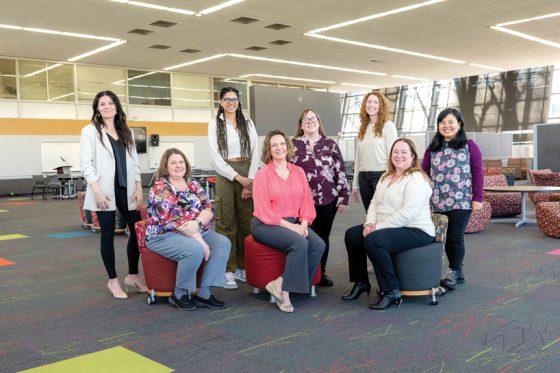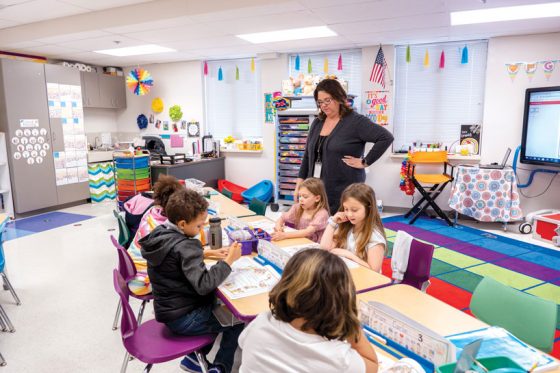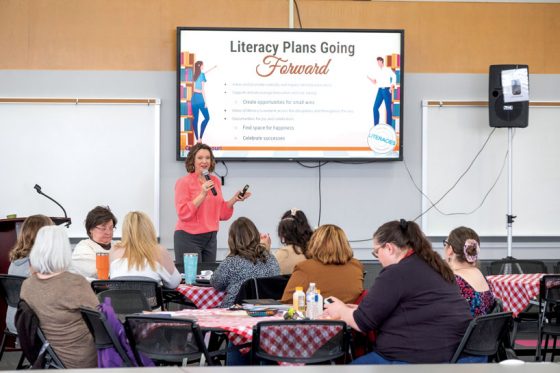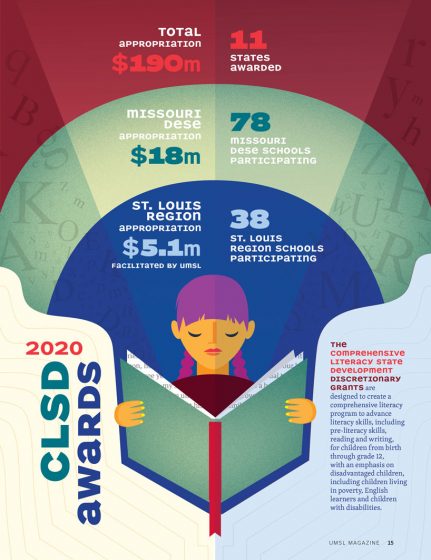
Teachers at Hancock Elementary School are implementing new literacy strategies with the help of a $5.1 million grant. Here, Reading Specialist and National Board Certified Teacher Cheryl Calcaterra reviews letter sounds with students. (Photo by August Jennewein)
Each day of the school week, Greenville Elementary teacher Kathryn Inman grabs a timer and gives her fifth-grade classroom a writing prompt: a song, perhaps, or maybe a poem or another piece of writing. She sets the timer for six minutes, puts on a little background music and lets them scribble away.
“I’ve never had a class that has started loving writing more than my class this year,” she says. “They just love these little writing prompts, and then they get to share out. In past years, there’d only be a few that would want to share. Now, my whole class wants to share every day.”
Those daily quick writes are just one literacy strategy Inman has implemented in her classroom through what she’s learned in the Gateway Writing Project’s Writing Institute, held on campus at the University of Missouri–St. Louis. A self-described lifelong learner, Inman took advantage of the opportunity to enroll in the institute’s new monthly program and pursue a master’s of education with an emphasis in reading through the Missouri Department of Elementary and Secondary Education’s Comprehensive Literacy State Development program. She says what she’s learned so far is already having a direct impact on the kids in her classroom.
“This is my first year implementing these types of strategies into my writing instruction, and I see a complete difference in how much the kids actually love writing and feel confident in their writing,” she says. “At the beginning of the year, I would say more than half of them were two or more grade levels below when it came to the ELA portion. That daily quick write and all these other strategies for active engagement really get them wanting to be there and wanting to write.”
***
In August 2020, Missouri DESE was awarded an $18 million grant for its CLSD program, which is designed to provide support and outreach in literacy education to students, educators and families in underserved areas throughout the state. To carry out the work of the grant, DESE contracted the Missouri Reading Initiative and the Show Me Literacies Collaborative, which includes literacy experts from the Missouri Writing Project Network (featuring three sites housed at UMSL, University of Missouri-Columbia and University of Central Missouri) and the Missouri Language and Literacies Center. Collectively, the collaborative is working with dozens of schools across the state of Missouri on reading, writing and inquiry.
The team at UMSL, led by co-principal investigators Shea Kerkhoff, assistant professor of literacy; Katie O’Daniels, assistant teaching professor of literacy and co-director of the Gateway Writing Project; and Nancy Singer, associate dean of the College of Education and an associate professor of English education, secured $5.1 million of the grant money to provide these services in the St. Louis region over five years.
“Given the opportunity gaps that exist when examining any national or statewide data and the ways in which existing racial and socioeconomic disparities were exacerbated with COVID, we believe that ensuring that all children are competent and confident readers, writers and thinkers – through educational practices that not only honor but sustain cultural and linguistic diversity – is a key civil rights issue for us to collectively address in these current times and with this generation of children,” O’Daniels says. “There’s an urgency to it.”
“Literacy is really important because it is related to life outcome,” Kerkhoff adds. “We know that children who can read fluently, comprehend and write fluently, creatively and critically have better chances for the kind of life that they want. They have self-actualization, meaning they can make the choices that they want to make in life. It’s super important, and it’s super important that all children are able to have that kind of life that they want. We saw that not all children in Missouri are at proficiency, and that’s what this grant is all about. The grant funding is helping us serve schools.”
In addition to Kerkhoff, O’Daniels and Singer, the grant allowed UMSL to expand its full-time team to carry out this work. Tracy Brosch, who also serves as co-director of the Gateway Writing Project, and Diana Hammond, assistant director of professional learning, are grant coordinators, and the team also includes several graduate research assistants.

The St. Louis region team consists of (from left to right) Leslie Hamm, Nancy Singer, Jasmin Easterling, Shea Kerkhoff, Tracy Brosch, Diana Hammond, Katie O’Daniels and Astri Napitupulu. (Photo by August Jennewein)
UMSL specifically is working with 38 schools – and reaching approximately 35,000 children – in the St. Louis region, which includes metropolitan St. Louis as well as the Greenville, Potosi and Williamsville areas. As nearly any member of the team will tell you, 40 schools is a considerable number, and each of those schools has unique needs. Due to the pandemic, the first year of the grant was largely spent over Zoom, which the team used as an opportunity to get to know the teachers and administrative leadership in the participating schools and build trust with them.
“I think one of the things that makes this grant different is that we really spent a lot of time in the first year or so doing a needs and assets conversation with the schools to develop their own literacy action plan,” Singer says. “The schools vary widely: We are working with most of the Normandy schools, but then we also have schools out in St. Charles County and schools in rural Missouri. This wasn’t us coming in and saying, ‘Everybody needs to do this one thing and then you’ll have great readers and writers in your school.’ But rather trying to understand the local context of schools – what kind of learners they have and what challenges they face – and trying to tailor what they needed in that action plan.”
As they hosted meetings and discussions with each of the schools and sent out surveys, four main themes started to emerge from an evaluation of needs and assets that have guided much of the work of the project. Teachers were eager to meet their schools’ needs for more culturally responsive texts and materials; expanded literacy across different disciplines such as history and mathematics; expanded family and community literacy; and ongoing professional learning on literacy. The team also worked with each school to develop a unique literacy action plan for taking what they’ve learned through this programming and putting it into action in their classrooms.
***
After the initial launch in the summer of 2021, the UMSL team has continued to expand its work each year. This year, they began offering three “pathways” for professional learning, all hosted on the UMSL campus throughout the year. The pathways demonstrate an expansive view of literacy, including reading and writing as well as speaking and listening, visual representation and creative, critical and computational thinking.
The literacy leadership pathway was designed to support those involved in the initial development of the literacy action plan and help them implement those plans, which vary widely across schools. One elementary school sought to make literacy more fun for students, so they built hallway libraries for kids to grab a book while waiting in line for the bathroom and started hosting dress-up days for beloved book characters. One middle school began planning a community literacy night, while another diversified its libraries with more culturally responsive books. A high school that wanted to grow literacy started its own book club.

Maria Krausz, a Hancock Elementary teacher who receives a tuition grant from UMSL, works on reading new vocabulary words in sentences with first grade students. (Photo by August Jennewein)
A second pathway, in coordination with the National Writing Project, focuses on source-based argumentation within different content areas such as ELA, science and social studies in grades 4 through 12. The program pulls from the National Writing Project’s College, Career and Community Writers Program (C3WP), a professional development program that provides teachers with resources and tools for the teaching of evidence- based argument writing. The program is hosted online, but the UMSL team also meets with teachers throughout the year to extend that work and connect as a group.
“We’re supporting teachers with inquiry-based reading and source-based writing and thinking about the need to understand the sources and talk back to them,” Hammond says. “How do they interact in form, shape or thinking as we have them in conversation with one another? We’re also ultimately looking at how they’re positioned in our society – what topics are relevant and urgent for us to investigate together in our community, whether the school community or a wider St. Louis community or statewide?”
The third pathway is an extension of the Summer Writing Institute that has been offered through the Gateway Writing Project since 1978. Offered at all National Writing Project sites, the intensive learning opportunity engages teachers of all subjects and grade levels in the pedagogy and practice of writing and is traditionally held Monday through Friday over four weeks in the summer. This year, in addition to hosting the traditional summer program, the team is piloting a yearlong Writing Institute to make it more accessible to teachers like Inman. Teachers can choose from a yearlong weekly evening class or a yearlong monthly full-day program with a three-day launch in August.
“It kind of seemed like the summer numbers were dwindling just because teachers are burned out and they need time off,” Brosch says. “It’s a full-day course, it’s four weeks – it’s a lot. So, with the support of the grant, we’ve been playing with other alternatives and thinking about what that looks like. How do we reach teachers in the way they want to be reached?”
That thought has been a guiding principle for the team as they seek to make these offerings accessible to all teachers.
***
While the pathways bring teachers to the UMSL campus, the team also goes directly to the schools to offer professional development workshops. This year’s workshops sought to address the priority goals developed during the literacy action planning, including source-based argumentation and inquiry, helping student writers grow through feedback and support and building a school culture of literacy, which O’Daniels says has proved most popular. “That’s been really well-received by schools because it’s kind of a starting point for moving the needle and really having that all-hands-on- deck mentality, but also thinking about literacy as something to be celebrated, something that’s joyful,” she says. “Because that brings our kids in; when they’re experiencing joy and being celebrated, that brings them to the table, that gets them on board.”

Shea Kerkhoff chats with educators at a Literacy Leaders Regroup on the UMSL campus in February. The event provided professional development on leading change and implementation science for the literacy teams to prepare for implementing their literacy action plans. (Photo by August Jennewein)
In addition to professional development offered both in schools and on the UMSL campus, the team has built a virtual professional learning community, the Show Me Literacies Community, which is hosted on the Participate platform. The community is free for all Missouri educators to join and features research-based resources on popular topics such as word study, motivation and engagement. Teachers can also participate in “pop-up PD,” which are two-week online courses that are slightly more structured and community-based. Soon, teachers will be able to receive digital badges for completing the courses.
“We have lots of opportunities for teachers to get involved with our network in kind of low- key ways,” O’Daniels says, “but we also have opportunities for teachers to get involved in more sustained ways that lead to teacher leadership and opportunities to work with other teachers in the region on professional development activities, study groups, conference presentations. We just want to be a professional support network for teachers because we know that teaching is hard and the teaching of literacy is complex.”
***
As in Inman’s case, the grant also supports continued learning for teachers in the form of tuition dollars. Each participating school receives $6,000 a year for tuition for any teacher in the school that can be used toward a graduate certificate in writing, K-12 certification in reading or other literacy instruction-related courses. So far, the grant has helped 49 graduate students enroll in literacy programs at UMSL, generating $148,259 in tuition for the College of Education. Schools also receive $800 each year to enact the goals of their literacy plans, whether for materials for students or stipends for teachers to work on those plans. On top of that, the grant provides additional tuition and stipends for teachers participating in the various pathways, such as the Writing Institute, “Summer Launch” professional development days or
the upcoming Literacy Leadership Academy.
In the remaining years of the grant, the team plans to continue supporting the implementation of those literacy plans, facilitating ongoing professional learning through the pathways and providing responsive school-site professional learning. This coming year, they will pilot a Literacy Leadership Academy, which will build on the work of the leadership pathway with more one-on-one professional development offered monthly.
“This is really in response to the needs of educators to be understanding and thinking about the science of reading and the evidence base around literacy teaching and learning,” O’Daniels says. “Literacy Leadership Academy is designed to start taking an inquiry-based focus on the research around literacy teaching and learning and using that type of space to bridge research and practice.”
Building a community of practice – in essence, a group that wants to learn and grow together – is a key tenet of the Gateway Writing Project and a major objective of the grant team. O’Daniels and Singer joke that they’ve done their job well when they’ve worked themselves out of a job by giving schools and teachers the tools they need to facilitate these professional development initiatives on their own. At the heart of the project is a deep-seated desire to use evidence-based research and practices to empower and encourage educators across the state.
“We don’t think that we have the magic pill or silver bullet that’s just going to – poof – all children everywhere in Missouri are now going to be at grade level,” Kerkhoff says. “But we do have hope that we can leverage evidence-based practices and share teacher knowledge with each other in ways that make teachers feel appreciated and valued, and that they would have the knowledge and support to have confidence in what they’re doing. And that would cascade down to the children, who would also have confidence that they can learn to read and comprehend and write well. I can’t measure that with a standardized test, but that’s what success looks like to me.”
This story was originally published in the spring 2023 issue of UMSL Magazine. If you have a story idea for UMSL Magazine, email magazine@umsl.edu.















